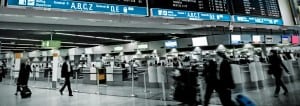
Part one of our guide to automated bag drop looked at the differences between one-step and two-step bag drops, and their advantages and disadvantages for an airport. In this part of the guide, we look at the affect of one-step and two-step automated bag drops on the whole airport, as well as some specific case studies.
How do automated bag drops affect an airport holistically?
With one-step, the advantages for an airline are a reduction in the cost of processes of check in (ie personnel) and, as the CUSS machines are permanently open, a reduction in queuing. This also impacts on queues landside, therefore decreasing the security risk. Two-step automated bag drop reduces the queues even further with a quicker processing time.
For the airport holistically, it is a moving problem elsewhere. Decreased queues in Check-In mean an increased pressure on security and baggage being put into the system much quicker than the system would normally handle. In this respect the pressure on the baggage handling system is ‘spikier’, with sharper peaks and troughs. Queues come and go quicker with automated bag drop.
How have automated bag drops been managed by airports?
AiQ have worked with several airports considering automated bag drops, enabling them to realise the impact throughout the airport with simulations, before any investment.
With Leeds Bradford Airport , 12 new two-step Self Service Bag Drop (SSBD) machines were proposed.
SSBDs can combine airline processes. With CUTE (Customer User Terminal Equipment), Airlines can combine DSCs (Departure Control Systems). This means that more than one airline can use the equipment, so potentially less desks and staff. This creates more opportunities to manage capacity by increasing flexibility.
In a three month project, by analysing the data with our bespoke 2D simulation software, TransvisionAiR, we were able to prove that 12 CUTE SSBDs would improve passenger flow at Check-In and reduce queues. We validated the proposal that these machines would be an advantage. However, although they would greatly improve queues in the Check-In hall, the machines would also create a bigger queue for security. We were able to propose increased capacity at security to balance the problem.
We were asked to provide cost efficient options for how Manchester Airport can manage growth, new entrants and expansion of airlines as they progress through the Manchester Transformation Programme (MTP). Over the next ten years, Manchester Airports Group (MAG) are expanding and re-configuring Terminal 2, to become the airport’s primary terminal building, and improving the existing Terminal 3. They will also demolish Terminal 1, to build a new improved terminal. We investigated the different options of airline Check-In for Manchester and areas to optimise terminal capacity, which included automated bag drop technology. With these detailed simulations and data, MAG are now able to have a range of validated options for terminals to consider during the transformation

